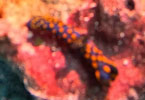_______________
Additional Photos

detail

upper gills

2nd animal

|
Tambja sagamiana (Baba, 1955)

Maximum size: about 50 mm.
Identification:
This
distinctive
animal has a bright blue body decorated with yellow tubercles surrounded
by gray rings. The rhinophores are black and the gills are olive-green with black bands on their upper sides. Like most Tambja spp, it has almond-shaped, retractile sensory organs below its rhinophores.
Natural history: Tambja sagamiana
is
known from two animals. The first was found crawling, by day, on the accretion
platform at Maalaea Bay, a moderately exposed to exposed rocky site. It was at
a depth of about 3 m (10 ft). The second was found at a rocky site at about 18 m (60 ft).
th
Distribution: Big Island and Maui: also known from Japan and Taiwan.
Taxonomic notes:
It
was first recorded in Hawaii from Maalaea Bay, Maui by Katherine Shepherd on Dec.
15, 2012.
Photo: Katherine Shepherd: about 50 mm: Maalaea Bay, Maui; Dec. 15, 2012.
Observations and comments:
Note
1: ( )
|
|




